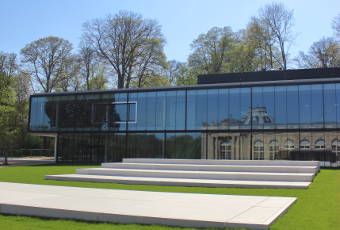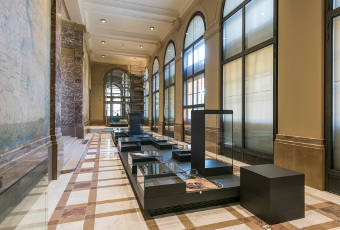The renovation of the AfricaMuseum
The AfricaMuseum reopened on 8 December 2018, after a five-year renovation.
When it came to the renovation, the big challenge was to present a contemporary and decolonised vision of Africa in a building which had been designed as a colonial museum.
Before the renovation, the permanent exhibition was outdated and its presentation not very critical of the colonial image. A new scenography was urgently required. As for the 1910 building, its infrastructure was no longer adapted to the requirements of a modern museum.
The buildings
 Access to the museum is now through the new visitor centre, which hosts a ticket office, shop, restaurant, picnic area for children and cloakrooms.
Access to the museum is now through the new visitor centre, which hosts a ticket office, shop, restaurant, picnic area for children and cloakrooms.
The visitor walks along the new underground gallery then heads into the basement of the former edifice, before resurfacing on the ground floor where the permanent exhibition is housed.
In the basement of the museum, an introductory exhibition looks at the past, the present and the future prospects of the institution. On the ground floor, the exhibition is divided up into five thematic zones, for the most part dedicated to Central Africa.
In the inner courtyard of the museum building, a light shaft has made it possible to create a space for musical workshops. The tiered seating is ideal for open air theatre.
The listed building was renovated and restored in keeping with the original plans which date back to the end of 19th century, whilst at the same time incorporating modern techniques.
The scenography
 The total surface area accessible to the public has increased from 6,000 to 11,000m². The scenography is the work of Niek Kortekaas and Johan Schelfhout. They have created a great balance between the restored listed windows and the new central platforms.
The total surface area accessible to the public has increased from 6,000 to 11,000m². The scenography is the work of Niek Kortekaas and Johan Schelfhout. They have created a great balance between the restored listed windows and the new central platforms.
The introduction of contemporary art is an important element in the renovation process.
The Congolese artist, Aimé Mpané was attributed the large rotunda project and created the work Nouveau souffle ou le Congo bourgeonnant, a large sculpture which enters into dialogue with the statues of colonial origin.
Given the fact that the history of the AfricaMuseum and its collections is shared by Belgians and the people of Central Africa and their diaspora, the institution wanted to involve them in the development of the permanent exhibition.
Stages in the renovation process
- 2003
An initial renovation proposal is presented to the press. - 2006
Renovation of the Royal Museum of Central Africa approved by the Council of Federal Ministers. - 2007
Didier Reynders, Deputy Prime Minister and Minister of Finance competent for the Belgian Buildings Agency, signs the task over to the multidisciplinary Temporary Association Stéphane Beel (TV SBA). - 2008
The Temporary Association SBA (Stéphane Beel Architects) submits a draft proposal for a masterplan of the entire site. - 2009
The architect submits the request for a building permit to the agence d’aménagement du territoire du Brabant flamand (Flemish Land Agency). - 2010
The Belgian Buildings Agency is granted the building permit for the renovation work and extension of the museum building. - 2012
- The project is published in the Bulletin des adjudications.
- Movement of the storage spaces and collections kept in the basement of the building is begun.
- 2013
- Servais Verherstraeten, State Secretary for the Belgian Buildings Agency, signs the dossier attributing the renovation works to the entrepreneur Denys. S.A.
- The offices and technical workshops that were housed in the museum building are moved out.
- 1st December: the museum closes its doors to the public.
- 2 December: the evacuation of public spaces is begun. In 15 days, all of the exhibition halls are emptied of their:
- 14 dioramas
- 260 mammals
- 200 birds
- 100 fish, reptiles and amphibians
- 1460 ethnographic objects and musical instruments
- 200 exhibits from the Colonial era History section
- 112 objects from the Congo River exhibition
- A few large exhibits such as the elephant, the giraffe and the pirogue.
- 2014
- The construction of the new visitor centre and the underground gallery gets underway, as does the renovation of the museum building.
- The excavation works for the underground gallery are carried out. A concrete-filled secant pile wall is constructed around it.
- In the museum building, demolition and evacuation of elements which were not there when it was first constructed gets underway. The marble, ironwork, parquet floor, wall and glass paintings are restored on site. The roofs are repaired and insulated; double chassis are placed to improve the insulation of exhibition halls.
- 2015 – 2016
- The works continue. The new visitor centre has now been given its final form, the glass façade has been placed and the museum’s grounds are once again looking like they did before its closure.
- The renovation works in the museum building are almost complete.
- 2017
- The museum’s grounds look almost identical to how they were before the works began, with the addition of a small contemporary touch.
- The construction of the visitor centre has been finalised and the works in the museum building are complete.
- A contract for multimedia productions in the new permanent exhibition is awarded.
- 2018
- The buildings (visitor centre and museum) are delivered by the Belgian Buildings Agency and taken receipt of by the museum.
- Work is begun on the layout of the visitor centre and the exhibition halls.
